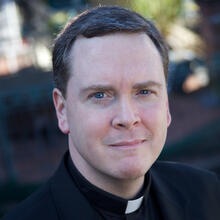On my desk at America Media headquarters sits a sealed glass bowl containing some dark, hardened soil from the tract of land my family tilled for more than two centuries in County Galway, Ireland. This is unsurprising, I suppose. When I try to count back through my 13 predecessors as editor in chief, I figure just over three-fourths of them were Irish by descent. (Typically, as I was composing the list with a colleague one night at one of the weathered, wooden tables at McSorely’s Old Ale House in Manhattan, a nearby wit with a heavy brogue suggested that we eliminate those Jesuits with obvious Italian surnames, like Tierney and O’Hare.)
Those Jesuit editors, of course, were always great sympathizers with the cause of Irish independence and with the plight of Irish immigrants. They were, to a man, great believers in the destiny of the Irish people, which included those here in the American diaspora, those who have now made such lasting contributions to the political, ecclesial and cultural life of this country.
That much seems obvious, but there are several other interesting things to note when viewing the literally hundreds of articles this magazine published, even counting only those between 1910 and 1930, about Ireland and the so-called Irish question.
The first is to notice something that we forget—that even if things were not as bad as they had been during the Famine or other periods of Irish history, the country was still terribly poor in those years. Eight hundred years of occupation cannot be undone in just a few decades. Ireland was rural, the country was impoverished and a significant portion of the country’s population was living in New York. Reading these articles, one is reminded that this was a time when subsistence or something slightly above it was all that the average Irishman could hope for. The United States was their life raft on a sinking ship.
The second thing to notice is the close connection between the faith and Irish culture. The Irish experience, of course, had been forged in a crucible of hardship, starvation and war. For the Irish people, the cross of Jesus Christ stood at the center of that history. For centuries Ireland had united her struggle to the cross of our Lord, drawing from his passion the strength, the courage, the hope to endure. Downtrodden and alienated from herself, Ireland placed her desperate faith in the crucified one, the stone that the builders rejected, which had become the cornerstone. Thus, with their eyes firmly fixed on the hope of heaven, a long-suffering people came to believe in the promise of a new Earth.
The third thing to notice is something many of us still feel today—a terrible nostalgia for the old country, for home. It reminds us that in its true meaning—from the Greek—nostalgia does not mean sentimentality about the past, but longing for a place—the old country, the auld sod. So many mentions of Ireland in the pages of America make it clear that while many Irish-Americans had bid farewell to the old country, they had never really left it behind—not just because they were always getting letters asking if maybe the American cousin couldn’t spare a few quid.
With Ireland now part of the European Union and with the ease of travel to the continent and even back and forth with the United States, what is most interesting is to go back to the stories of those years in the early life of America magazine—the magazine was founded just seven years before the Easter Rising—and hear firsthand the stories that today might be only echoes, but that might also provide a useful point of reference for those of us who are debating how to welcome the huddled masses who arrived only this morning.








